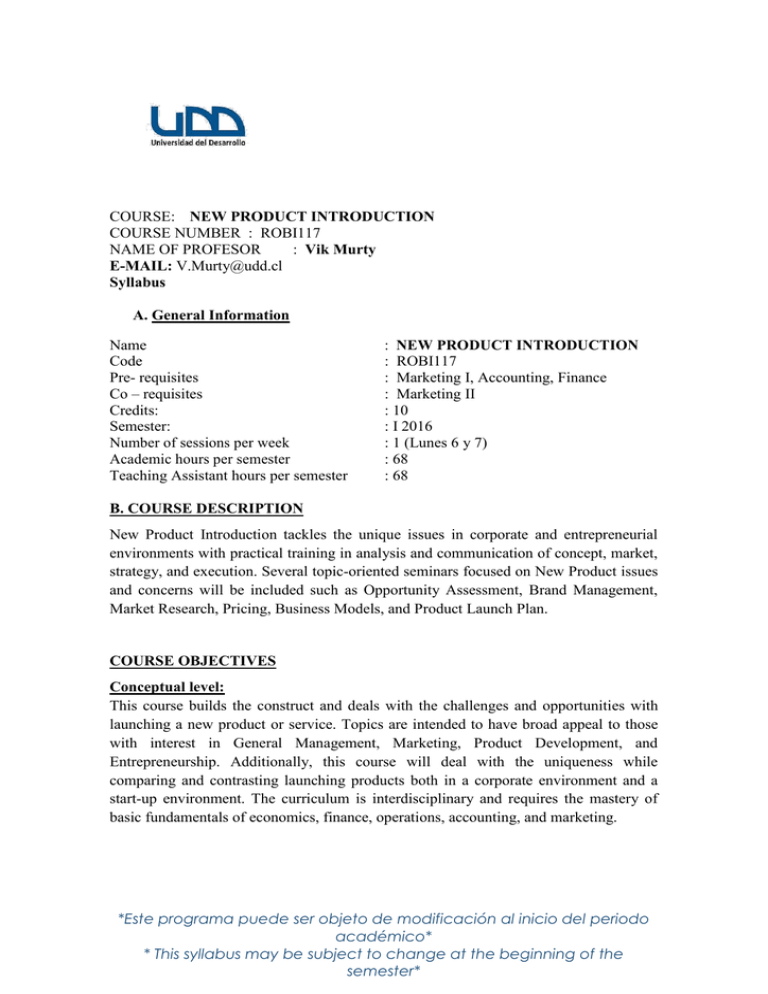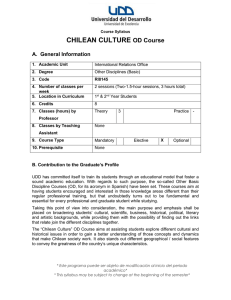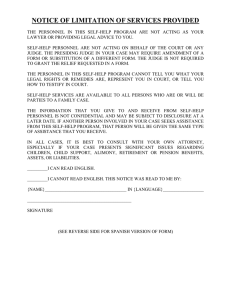*Este programa puede ser objeto de modificación al inicio del
Anuncio

COURSE: NEW PRODUCT INTRODUCTION COURSE NUMBER : ROBI117 NAME OF PROFESOR : Vik Murty E-MAIL: [email protected] Syllabus A. General Information Name Code Pre- requisites Co – requisites Credits: Semester: Number of sessions per week Academic hours per semester Teaching Assistant hours per semester : NEW PRODUCT INTRODUCTION : ROBI117 : Marketing I, Accounting, Finance : Marketing II : 10 : I 2016 : 1 (Lunes 6 y 7) : 68 : 68 B. COURSE DESCRIPTION New Product Introduction tackles the unique issues in corporate and entrepreneurial environments with practical training in analysis and communication of concept, market, strategy, and execution. Several topic-oriented seminars focused on New Product issues and concerns will be included such as Opportunity Assessment, Brand Management, Market Research, Pricing, Business Models, and Product Launch Plan. COURSE OBJECTIVES Conceptual level: This course builds the construct and deals with the challenges and opportunities with launching a new product or service. Topics are intended to have broad appeal to those with interest in General Management, Marketing, Product Development, and Entrepreneurship. Additionally, this course will deal with the uniqueness while comparing and contrasting launching products both in a corporate environment and a start-up environment. The curriculum is interdisciplinary and requires the mastery of basic fundamentals of economics, finance, operations, accounting, and marketing. *Este programa puede ser objeto de modificación al inicio del periodo académico* * This syllabus may be subject to change at the beginning of the semester* 1. Utilize business and marketing skills to understand the challenges of creating introducing new services and products and apply this understanding to effectively manage a variety of new venture business settings *Este programa puede ser objeto de modificación al inicio del periodo académico* * This syllabus may be subject to change at the beginning of the semester* 2. Use the power of customer centric marketing to define nascent products/services both in corporate and entrepreneurial settings and make a positive impact within a company and in the marketplace 3. Define separate constructs for product generation, marketing, and communication Procedural level: 1.Build a process that tackles a circumspect set of tasks and issues from Markets to investors to Internal groups and provides the flexibility in a chaotic system to deal with nascent product issues. Build a Product Launch Plan. 2.Define the product/service with customer centricity through research, thought processes, and intuition 3.Learn to communicate new product strategies and execution with internal management, investors, and the market. Learn to develop the right decision making unit at the right point throughout the New Product Launch process Attitudinal level: 1.-Appreciate and address the major types of problems facing the new product manager: such as communicating and negotiating with marketing managers, general management, product development, finance, and entrepreneurs with an emphasis on developing sound strategy and effective tactical execution 2.- Understand the chaotic nature of nascent products and the need to create feedback loops and flexibly but responsibly morph business model and product as information is available. 3. Improve the ability to communicate complex issues in a clear, concise and compelling manner. Contents: 1. First unit: Cross-functional Foundations Conceptual: Define Marketing broadly as a function across an organization Define the Product Process Construct Define the Marketing Construct Communications strategies for strategic storytelling *Este programa puede ser objeto de modificación al inicio del periodo académico* * This syllabus may be subject to change at the beginning of the semester* Procedural: *Este program a puede ser objeto de modifica ción al inicio del periodo académi co* * This syllabus may be subject to change at the beginnin g of the semester * Develop a target-oriented intuition that helps the students make memorable emotionally driven point(s) 2. Second unit: Business Model Design Conceptual: The power of customer centric vantage point in defining products Diffusion principles of word-of-mouth especially in new era of social media New business model and product creation Procedural: Analyze and define customer needs Identify customer segments as the first and important step in successful new product introduction (can be counter-intuitive) Build a canvas for new product introduction 3. Third unit: Customer Centricity: segmentation, target market selection and positioning Conceptual: Differentiate between market segments and personify Establish a positioning strategy for brands and products Procedural: 1. Define product 2. Apply the segmentation variables to create segments, personify, and target 3. Align the positioning strategy with the differentiation efforts of the new product offering and morph product offering 4. Fourth unit: Opportunity Assessment Conceptual: Understand how to identify and evaluate an opportunity GO/NO GO and STOP Strategy tools to identify and define opportunity and adjust as necessary Balancing Passion vs. Flexibility Procedural: Analyze markets Utilize tools to identify and communicate opportunities 5. Fifth unit: Brand Management Conceptual: *Este programa puede ser objeto de modificación al inicio del periodo académico* * This syllabus may be subject to change at the beginning of the semester* Basic brand definition principles *Este programa puede ser objeto de modificación al inicio del periodo académico* * This syllabus may be subject to change at the beginning of the semester* Understand the relationship between corporate and brand strategy Understand Brand Architecture vs. Brand Valuation Understand the importance of effective brand management for new products and consequences of poor management Identify positives and negatives of a launch within existing brand vs. new brand Procedural: Brand mapping Developing a brand architecture Create a messaging structure and apply to new product space 6. Eighth Unit: Pricing Strategy Conceptual Basic pricing dynamics for new products Know the different techniques for establishing a price Understand the difference between value-based pricing and other techniques How to deal with changing segments and pricing models Specific new product challenges driven by technology pricing FREE! Procedural Identify when to use various pricing and promotional techniques such as free, gift with purchase, trial, subsidy (Gillette model), and bundles Be able to establish a price(s) for a new product or service 7. Ninth Unit: Product Development and Road Map Conceptual Know the characteristics of new products in the context of product road map Understand the difference between product iteration, differentiation, and introduction Identify people within an organization that have vested interests and concerns about new product launches Procedural Be able to create and present a product road map for various roles Use techniques and messaging to influence and position new products internally as well in the marketplace 8. The Product Launch Plan Conceptual Know the characteristics and ingredients of a Product Launch Plan Managing, evaluating, and refining launch plans managing risk and uncertainty *Este programa puede ser objeto de modificación al inicio del periodo académico* * This syllabus may be subject to change at the beginning of the semester* Executing and course correcting and redefining products, iterations, or new categories *Este programa puede ser objeto de modificación al inicio del periodo académico* * This syllabus may be subject to change at the beginning of the semester* Procedural Create, evaluate, and communicate launch plans Beginning to end launch plan in groups of real products Attitudinal objectives for all New Product Launch plans: Encourage analytical thinking and written/oral English skills. Manage proficiently both the strategic elements and the tactics of execution of elements. Value successful and unsuccessful product launches studied on each of the case analyses that will ultimately allow students build a strong intuition and ability to execute. ASSIGNMENTS PREPARATION GUIDELINES It is advisable to start working on the case studies/videos only after having completed the related reading of the course material, since the assignments are related to the chapter topics E. COURSE METHODOLOGY Various forms of learning will be used including lectures, business cases, and potentially professional guest speakers. Readings in English will include textbook and business literature excerpts. Current business events may be discussed as relevant. Broadly, this class positions marketing a discipline writ large and gives students practice of the ability to add value through customer centric vantage point for new product definition, execution and evaluation. All material presented in English. Role of professor: to teach to acceptable professional standards such that student has actionable capabilities conceptually and practically. To treat the class as if they are stakeholders in a company, and evaluate incorporate student perspective and point of view. The professor is the “facilitator” of student learning. Role of student: Be prepared: read the cases, read the assigned literature and notes, have questions ready, challenge peers and professor courteously, build well prepared arguments. Be aware: during this class look at life through the lens of a marketer in every touchpoint with products – from a sip of bottled water to grocery shopping, to walking shopping malls. Read, lots online. You can and should incorporate any external learning and knowledge. Be engaging: participate, voice yourself, don’t let “dead space” go useless as there are lots of topics and interesting tangents to cover. Take active responsibility for your learning. *Este programa puede ser objeto de modificación al inicio del periodo académico* * This syllabus may be subject to change at the beginning of the semester* Papers, presentations, and communications are evaluated on completeness, clarity and conciseness. Plenty of opportunity to hone these skills throughout the class. End of class capability and growth are critically important. *Este programa puede ser objeto de modificación al inicio del periodo académico* * This syllabus may be subject to change at the beginning of the semester* F EVALUATION 1. 2. 3. 4. 5. Group Exercises: 20% Cases and Class Participation (individual) 25% Mid term (individual) 12.5% Mid term 2 (group) 12.5% Final exam: Product Launch Plan, group paper (less than five pages), brief, boards and presentation 30% G EVALUATION DESCRIPTION Group Exercises [20%] A few group exercises will contribute to this mark. Evaluation will be made based upon success of the group AND upon individual contribution within group. Each group member will “professionally and constructively” evaluate each other group member. Time permitting, each group will “professionally and constructively” evaluate and feedback each other group. Marks will also be dependent upon evaluation and feedback. Cases and class participation 25% You are required to complete reading cases weekly during the semester; each case is strategically selected to give you a practical perspective that should enable you to have a marketing and managerial outlook on the situation that is being analyzed. Each case due date is clearly noted in the week to week calendar and the weeks topic. you do have the option to work in groups. Marks are based on individual remarks based on depth, contextual understanding, originality, and evaluation/analysis. There maybe case reports scheduled for certain weeks in lieu of discussion, but with advanced warning. Mid Term Exams [25%] total (I: Individual written, II: Group) You are required to complete 2 in class Tests/Certamen as per the normal Subject requirements that you are familiar with during each semester, these are designed to test your understanding of the key concepts covered in each of the learning modules. Task Length – Each test will have a maximum time length of 1 hour and 20 minutes, but may require pre class prep (reading and prepping a case as an example). Test 1 12.5% Test 2 12.5% Product Launch plan and presentation (Group) – 30% This major project is a group task that deals with a new product or service. This assignment is designed to encourage you to gain as many different perspectives as you can, to work as a group and to develop communication skills. The written report on this project should be no more than two pages (excluding appendices): executive brief. A *Este programa puede ser objeto de modificación al inicio del periodo académico* * This syllabus may be subject to change at the beginning of the semester* title page (with student name, id number, and project title and a reference list must be included. Use clear and concise language with exceptional clarity and please carefully edit the assignment for grammatical and spelling errors. Imagine you are presenting to your CEO. In your group, you will work with a real product you support and create a Product Launch plan with Product definition, Roadmap, Communication Plan, and Market and Opportunity Understanding. For this project, ample class time will be provided with aid from T/A and Professor to be equally distributed by group. All efforts should be made to select a product that is real from a company that is accessible. All external research is permitted and encouraged, maybe presented in time allotted, and incorporated into the creation of the product launch plan. During company/product selection early in the term, professor and t/a can aid with possible contacts BUT the final responsibility of selection and research is lies with the group. Specifics regarding requirements and evaluation in more detail will follow post midterm. H TEXT AND MATERIALS REQUIRED HBR INDUSTRY AND BACKGROUND NOTE Hypothesis-Driven Entrepreneurship: The Lean Startup Thomas R. Eisenmann; Eric Ries; Sarah Dillard Added on Dec 30, 2015 Details HBR ARTICLE Preparing for the Perfect Product Launch James P. Hackett Added on Dec 30, 2015 Details HBR CORE CURRICULUM READING Marketing Reading: Segmentation and Targeting Sunil Gupta Added on Dec 30, 2015 Details HBR INDUSTRY AND BACKGROUND NOTE Marketing Research Fareena Sultan Added on Dec 30, 2015 Details HBR INDUSTRY AND BACKGROUND NOTE Market Segmentation, Target Market Selection, and Positioning Miklos Sarvary; Anita Elberse Added on Dec 30, 2015 Details HBR INDUSTRY AND BACKGROUND NOTE Pricing, Profits and Customer Value Frank V. Cespedes; Benson P. Shapiro; Elliot B. Ross Added on Dec 30, 2015 Details HBR FORETHOUGHT ARTICLE Why Most Product Launches Fail Joan Schneider; Julie Hall Added on Dec 30, 2015 Details *Este programa puede ser objeto de modificación al inicio del periodo académico* * This syllabus may be subject to change at the beginning of the semester* BOOK READINGS & EXCERPTS: The Lean Startup: How Today's Entrepreneurs Use Continuous Innovation to Create Radically Successful BusinessesSep 13, 2011 by Eric Ries ( Required excerpts, recommended reading of full book) Leading the RevolutionJul 30, 2002 by Gary Hamel (Required Excepts) Beyond Bullet Points by Cliff Atkinson (Required excerpts, recommended reading of full book) Trading Up: Why Consumers Want New Luxury Goods--and How Companies Create ThemApr 29, 2008 by Michael J. Silverstein and Neil Fiske (Required excerpts, recommended reading of full book) Purple Cow by Seth Godin (Required excerpts, recommended reading of full book) Crossing the Chasm, 3rd Edition: Marketing and Selling Disruptive Products to Mainstream Customers (Collins Business...Jan 28, 2014 by Geoffrey A. Moore (Required excerpts, recommended reading of full book) HBS Cases will be assigned in advance Optional reading list: Killer Brands: Create and Market a Brand That Will Annihilate the Competition Action Trumps Everything: Creating what You Want in an Uncertain WorldBook by Charles F. and Kiefer, Leonard A. Schlesinger, Paul B. Brown n m3.8/5·AbeBooks n mn mOriginally published: 2010 n mAuthors: Charles F. Kiefer, Leonard A. Schlesinger, Paul B. Brown *Este programa puede ser objeto de modificación al inicio del periodo académico* * This syllabus may be subject to change at the beginning of the semester*


